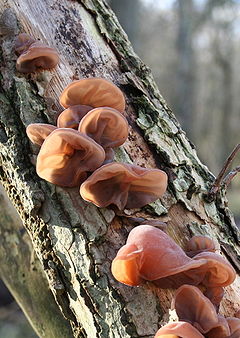Auriculariales
| Auriculariales | |
|---|---|
 |
|
| Auricularia auricula-judae | |
| Scientific classification | |
| Kingdom: | Fungi |
| Division: | Basidiomycota |
| Class: | Agaricomycetes |
| Order: |
Auriculariales J. Schröt. (1889) |
| Families | |
|
Aporpiaceae genera incertae sedis (no family) |
|
| Synonyms | |
|
Aporpiales Bond. & M. Bond. (1960) |
|
Aporpiaceae
Auriculariaceae
Heteroscyphaceae
Hyaloriaceae
Oliveoniaceae
Patouillardinaceae
Tremellodendropsidaceae
genera incertae sedis (no family)
Aporpiales Bond. & M. Bond. (1960)
Exidiales R.T. Moore (1996)
The Auriculariales are an order of fungi in the class Agaricomycetes. Species within the order were formerly referred to the "heterobasidiomycetes" or "jelly fungi", since many have gelatinous basidiocarps (fruit bodies) that produce spores on septate basidia. Around 200 species are known worldwide, placed in six or more families, though the status of these families is currently uncertain. All species in the Auriculariales are believed to be saprotrophic, most growing on dead wood. Fruit bodies of several Auricularia species are cultivated for food on a commercial scale, especially in China.
The order was established in 1889 by German mycologist Joseph Schröter to accommodate species of fungi having "auricularioid" basidia (more or less cylindrical basidia with lateral septa), including many of the rusts and smuts. In 1922, British mycologist Carleton Rea recognized the order as containing the families Auriculariaceae and Ecchynaceae, as well as the rusts (Coleosporiaceae and Pucciniaceae) and the smuts (Ustilaginaceae). Many subsequent authors, however, separated out the rusts and smuts and amalgamated the remaining Auriculariales with the Tremellales. Jülich (1981) also separated out the rusts and smuts, but recognized the remaining Auriculariales as an independent order, placing within them the families Auriculariaceae, Cystobasidiaceae, Paraphelariaceae, Saccoblastiaceae, Ecchynaceae, Hoehnelomycetaceae, and Patouillardinaceae.
...
Wikipedia
